
The U.S. National Park Service is anticipating so many visitors this summer that you actually need a reservation just to enter some of them. And with a record number of people becoming one with nature, you’re going to have some unintended, but not completely unexpected, consequences. I am, of course, referring to the litany of people who’ve visited a national park and wound up on the wrong side of a bison attack.
The National Park Service of Yellowstone Park says more people have been injured by bison than any other animal—not bears, which is the animal many of us are most concerned with preparing a defense against. Is the guidance transferable from bear to bison, though? The answer is sometimes yes, and sometimes no. Here’s what you need to know if you’re visiting a national park this summer and don’t want to become the latest victim of a bison attack.
The official guidance for dealing with bison
When you encounter a bison in the wild, the National Park Service recommends you stay at least 25 yards away from the animal because bison are unpredictable and can run three times faster than humans. Additionally, the Utah Division of Wildlife Resources echoes this guidance, with Antelope Island Park Manager Jeremy Shaw explaining that attacks happen when people get too close: “They always want to get closer and closer for photos. But ultimately, any time there is a dangerous interaction with wildlife, it’s because the person got too close.”
Nevertheless, it’s possible to encounter an aggressive bison in the wild through no fault of your own. In that case, the Utah Division of Wildlife Resources recommends the following: “If you see a bison and it stops what it is doing and starts paying attention to you, you are too close and should slowly back away.” Lastly, NPS instructs to never feed any animals you encounter, including bison. They explain animals that become dependent on human food, sometimes become aggressive toward people, and then ultimately have to be killed.
How bison guidance differs from bear guidance
One difference between bear encounters and bison encounters is if you’re anticipating encountering a bear, you’re better off traveling in a larger group, whereas if you anticipate encountering bison, you’re going to want to be in a smaller group. An NPS study regarding human injuries resulting from bison encounters at Yellowstone National Park concluded, “the number of persons near bison not only influences human behavior, it likely causes bison to feel threatened, and bison react with physical force.” This differs from the NPS guidance for bear safety, which encourages hikers to travel in larger groups, as bears will find this intimidating.
Another key difference between a bison encounter and a bear encounter is the advice of “making yourself large.” When you encounter a bear, you’re encouraged to make yourself look as large as possible—there is no such reason to do so with a bison. According to the National Parks Experience, “Unlike other wild animals like black bears, grizzly bears and especially mountain lions, making yourself large and making noise will not scare off a bison. This will not deter an angry bison.” T
The NPS also advises against climbing or running away when encountering a bear, whereas it’s not as black-and-white with bison. The NPS says to “always have an escape plan by identifying nearby protective cover like trees and cars. If there’s no cover, turn around or wait for the bison to leave the area.”
Lastly, a fundamental difference between bison encounters and bear encounters is that bison are herbivores, whereas bears are not. Bison don’t attack with the intent of making you their next meal; the only reason they’ll get aggressive is if you’ve invaded either their personal space, or their calves’ personal space.
Credit: Source link



